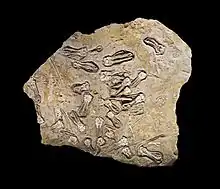Artinskian
In the geologic timescale, the Artinskian is an age or stage of the Permian. It is a subdivision of the Cisuralian Epoch or Series. The Artinskian likely lasted between 290.1 and 283.5 million years ago (Ma) according to the most recent revision of the International Commission on Stratigraphy (ICS) in 2022.[1] It was preceded by the Sakmarian and followed by the Kungurian.
| Artinskian | |||||||||||||
|---|---|---|---|---|---|---|---|---|---|---|---|---|---|
| Chronology | |||||||||||||
| |||||||||||||
| Etymology | |||||||||||||
| Name formality | Formal | ||||||||||||
| Usage information | |||||||||||||
| Celestial body | Earth | ||||||||||||
| Regional usage | Global (ICS) | ||||||||||||
| Time scale(s) used | ICS Time Scale | ||||||||||||
| Definition | |||||||||||||
| Chronological unit | Age | ||||||||||||
| Stratigraphic unit | Stage | ||||||||||||
| Time span formality | Formal | ||||||||||||
| Lower boundary definition | FAD of the Conodont Sweetognathus whitei | ||||||||||||
| Lower boundary GSSP | Dalny Tulkas section, Southern Ural Mountains, Russia 53.9247°N 56.51615°E | ||||||||||||
| GSSP ratified | February 2022[2] | ||||||||||||
| Upper boundary definition | Not formally defined | ||||||||||||
| Upper boundary definition candidates | Near FAD of the Conodont Neostreptognathodus pnevi | ||||||||||||
| Upper boundary GSSP candidate section(s) | Mechetlino, Southern Ural Mountains, Russia | ||||||||||||
Stratigraphy

The Artinskian is named after the small Russian city of Arti (formerly Artinsk), situated in the southern Ural mountains, about 200 km southwest of Yekaterinburg. The stage was introduced into scientific literature by Alexander Karpinsky in 1874.[3]
Base of the Artinskian
The base of the Artinskian Stage is defined as the first appearance datum (FAD) of the conodont species Sweetognathus whitei and Mesogondolella bisselli. In order to constrain this age, the ICS subcommission on Permian stratigraphy informally proposed a candidate GSSP in 2002, later followed by a formal proposal in 2013. The proposed GSSP location - the Dal'ny Tulkas roadcut in the Southern Urals, near the town of Krasnousolsky[4] - was eventually ratified in February 2022.[2]
U-Pb radiometric dating found that the base of the Artinskian was approximately 290.1 million years old (Ma), based on the position of the rock layer at the Dal'ny Tulkas roadcut containing the FAD of S. whitei relative to three precisely dated ash beds surrounding it.[5] Earlier radiometric reported a much younger age of 280.3 Ma for the Sakmarian-Artinskian boundary.
Top of the Artinskian
The top of the Artinskian (and the base of the Kungurian) is defined as the place in the stratigraphic record where fossils of conodonts Neostreptognathodus pnevi and Neostreptognathodus exculptus first appear.[3]
References
- "Chart/Time Scale". www.stratigraphy.org. International Commission on Stratigraphy.
- "Ratification of Artinskian GSSP". International Commission on Stratigraphy. International Commission on Stratigraphy. Retrieved 23 March 2022.
- Gradstein, Felix M.; Ogg, James G.; Smith, Alan G. (2004). A Geologic Time Scale 2004. ISBN 9780521786737.
- Chuvashov, Boris I.; Chernykh, Valery V.; Shen, Shuzhong; Henderson, Charles M. (2013). "Proposal for the Global Stratotype Section and Point (GSSP) for the base-Artinskian Stage (Lower Permian)". Permophiles. 58: 26–34.
- Schmitz, Mark D.; Davydov, Vladimir I. (March–April 2012). "Quantitative radiometric and biostratigraphic calibration of the Pennsylvanian–Early Permian (Cisuralian) time scale and pan-Euramerican chronostratigraphic correlation". Geological Society of America Bulletin. 124 (3/4): 549–577. Bibcode:2012GSAB..124..549S. doi:10.1130/B30385.1.
External links
- GeoWhen Database - Artinskian
- Upper Paleozoic stratigraphic chart at the website of the subcommission for stratigraphic information of the ICS